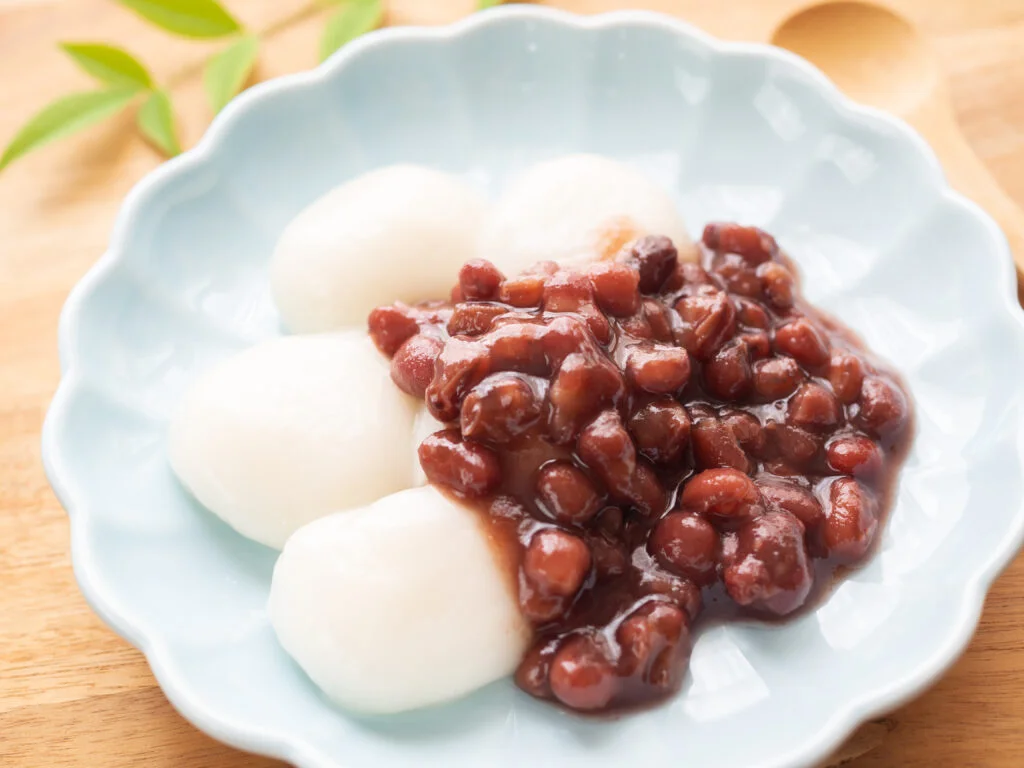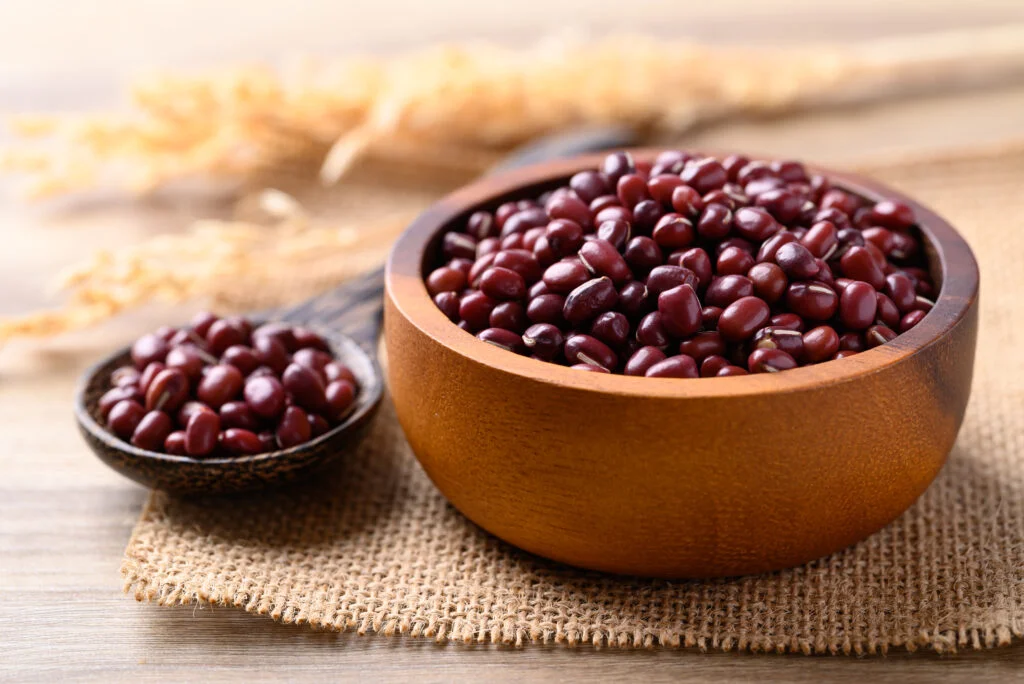Azuki Beans: The Hidden Health Powerhouse in Wagashi
When you think of wagashi, Japanese traditional sweets, you might imagine beautifully crafted confections with a delicate sweetness. But did you know that the main ingredient, azuki beans, has surprising health benefits? Let’s delve into the hidden nutritional power of azuki beans and how they contribute to making wagashi more than just a treat for your taste buds.

Azuki’s Nutritional Profile: An Unexpectedly Healthy Ingredient
Azuki beans are not only crucial for the flavor of wagashi but also pack a nutritional punch. Interestingly, azuki beans contain about two-thirds the amount of protein found in soybeans, which are renowned for their high protein content. Additionally, they’re rich in dietary fiber and polyphenols with powerful antioxidant properties, making them a nutritional powerhouse. Here’s a breakdown of the main nutrients found in azuki beans:
- Protein: Azuki beans are an excellent source of plant-based protein. Boiled azuki beans contain about 8.6g of protein per 100g, which helps maintain muscle mass and repair body tissues.
- Dietary Fiber: Rich in dietary fiber, boiled azuki beans contain approximately 8.7g per 100g. This high fiber content is believed to help prevent constipation and improve gut health.
- Polyphenols: The polyphenols in azuki beans have antioxidant properties that may help reduce oxidative stress in the body and potentially prevent various diseases.
- Vitamins and Minerals: Azuki beans contain B vitamins, iron, potassium, and magnesium, which support various bodily functions.
| Food Item | Energy (kcal) | Protein (g) | Fat (g) | Carbs (g) | Fiber (g) | Sugar (g) |
|---|---|---|---|---|---|---|
| Azuki Beans (Dried) | 304 | 20.8 | 2.0 | 59.6 | 24.8 | 46.5 |
| Azuki Beans (Boiled) | 124 | 8.6 | 0.8 | 25.6 | 8.7 | 18.2 |
| Canned Boiled Azuki | 202 | 4.4 | 0.6 | 49.2 | 3.4 | 47.7 |
| Koshi an | 147 | 9.8 | 0.6 | 27.1 | 6.8 | 26.0 |
Reference: Standard Tables of Food Composition in Japan 2020 (8th Revision)
Azuki Beans and Diet: An Unexpected Ally
Azuki beans can be surprisingly beneficial for those watching their weight. Here’s why:
- Low Glycemic Index (GI): Azuki beans have a low GI, which means they can help prevent rapid spikes in blood sugar levels. This can potentially reduce insulin secretion and fat storage.
- Satiety: The high fiber content in azuki beans can help you feel full for longer, potentially reducing overeating.
- Blood Sugar Control: The fiber and polyphenols in azuki beans are believed to slow down sugar absorption, which may help in controlling blood sugar levels and potentially aid in diabetes prevention.
- Cholesterol Reduction and Health Benefits: The fiber in azuki beans may help reduce cholesterol absorption. Moreover, saponins found in the azuki bean skin offer various health benefits:
- Prevention of cholesterol and triglyceride increase
- Blood sugar level control
- Improvement of blood circulation
- Potential prevention of arteriosclerosis, myocardial infarction, and cerebral infarction
- Promotion of diuretic effects and prevention of edema
These effects suggest that azuki beans may contribute not only to improving blood cholesterol levels but also to overall health maintenance. However, it’s important to note that many of these effects are still under research and individual results may vary.

Furthermore, the recent popularity of “azuki water” in Korea and Taiwan is worth noting. Azuki water is a simple drink made by soaking azuki beans in water and has gained popularity for its potential diet effects. The dietary fiber and polyphenols in azuki water are believed to help reduce swelling and have diuretic properties.
You can easily make “azuki tea” at home as well. Here’s a popular recipe from Cookpad:
Why not try making this healthy azuki tea at home using this recipe as a reference?
Azuki’s Sugar Content: Misconceptions and Truths
While azuki beans (anko) are often associated with high sugar content, the beans themselves are not particularly high in sugar. Per 100g, raw azuki beans contain about 46.5g of sugar, which is actually lower than white rice (about 75g).
The high sugar content in wagashi often comes from added sugar during preparation. However, it’s possible to make low-sugar azuki paste at home. Here are some tips:
- Use low-calorie sweeteners instead of sugar
- Reduce sugar and add flavor with spices like cinnamon or vanilla
- Use agar, which is rich in dietary fiber, along with azuki beans
These adjustments can help you enjoy healthier wagashi without compromising on taste.
Enjoying Wagashi the Healthy Way
To enjoy wagashi in a health-conscious manner, consider these tips:
- Mind the Portion: While nutritious, wagashi are still sweets. Enjoy them in moderation.
- Timing Matters: Consider having wagashi in the morning or afternoon when you’re more active.
- Pair with Tea: Enjoying wagashi with green tea can provide additional antioxidant benefits from catechins.
- Balance Your Diet: Include wagashi as part of a balanced diet, not as a standalone meal.
Modern Wagashi: Blending Health Consciousness with Tradition
Recent years have seen the emergence of health-conscious wagashi, such as:
- Low-sugar wagashi using alternative sweeteners
- Wagashi incorporating superfoods like quinoa or chia seeds alongside azuki
- Vegetable-based wagashi using nutritious ingredients like pumpkin or sweet potato
These modern interpretations maintain traditional flavors while catering to contemporary health concerns.
Conclusion: Enjoying the Sweet Balance of Flavor and Health in Wagashi
Azuki-based wagashi offer surprising health benefits alongside their delightful taste. Rich in protein, dietary fiber, and antioxidants, azuki beans can contribute to health maintenance and potentially aid in weight management when consumed appropriately.
However, it’s crucial to remember that moderation is key. Wagashi should be enjoyed as part of a balanced diet, not as a primary source of nutrition.
The charm of wagashi lies in its beautiful appearance, seasonal sensitivity, and deep flavors. Now that we understand its potential health benefits, we can appreciate wagashi not just for its taste but also for its nutritional value. This new perspective might help you discover a whole new dimension to these traditional Japanese sweets.
Finally, remember that nutritional needs vary among individuals. If you’re considering significant changes to your diet, including increasing your wagashi intake, it’s always wise to consult with a healthcare professional.
